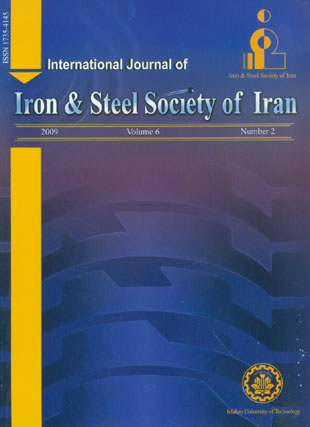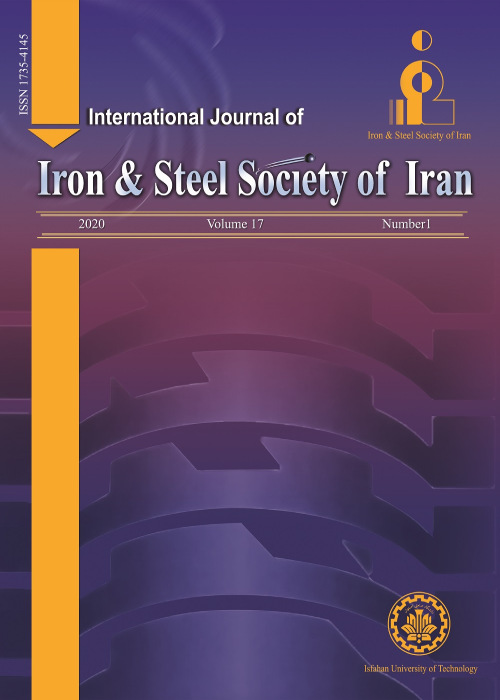فهرست مطالب

International Journal of iron and steel society of Iran
Volume:6 Issue: 2, Summer and Autumn 2009
- 40 صفحه،
- تاریخ انتشار: 1389/11/01
- تعداد عناوین: 7
-
-
Page 1Recently, bulk nano-structured materials produced by severe plastic deformation (SPD) have attracted scientists attention. Materials produced by SPD are of great importance because of (1) non-porous structure, (2) great mechanical properties such as high strength and toughness and (3) proper dimension for mechanical and physical testing. Several methods have been introduced for imposing the severe plastic deformation on the metals. In this research, pressing in corrugation dies is carried out on the sheets of low carbon steel at room temperature. The potential of this method in grain refinement and mechanical properties improvement of low carbon steel sheets is investigated using XRD, tensile and hardness tests. The results show that in strain magnitude of 4.64, a microstructure with a grain size of 230 nm is achieved.
-
Page 6An artificial neural network (ANN) model is developed for the analysis, simulation, and prediction of the austenite reversion in the thermo-mechanical treatment of 304L austenitic stainless steel. The results of the ANN model are in good agreement with the experimental data. The model is used to predict an appropriate annealing condition for austenite reversion through the martensite to austenite transformation. This model can also be used as a guide for further grain refining and to improve mechanical properties of the AISI 304L stainless steel.
-
Page 14Ni-W coatings, compared to pure nanocrystalline Ni, exhibit higher hardness and wear resistance. In some cases, these coatings are considered as environmental friendly alternatives for hard chromium coating. Till now, most of Ni-W coatings have been produced by direct current electrodeposition from alkaline baths. In this study square pulse current was used for deposition of Ni-W precipitates from Watts bath. The effect of current density and duty cycle on morphology and wear behavior of nano-structured Ni-W coatings was investigated. The structure and morphology of the coatings were studied using X-ray diffraction (XRD) and scanning electron microscopy (SEM) techniques, respectively. Mechanical and tribological properties of the deposits were also investigated by means of microhardness and pin-on-disk wear tester. The results showed that a decrease in current density and duty cycle increased the W content of Ni-W coating. This increase led to an increase in hardness and improved the wear resistance of nanocrystalline coatings.
-
Page 20Determination of stockpile weight and stockpile inventory are critical to any quarry or mining operation, whether it is required by accounting firms or used internally for the quarterly balance of production and sales. Generally, errors and problems originate from two factors. Volume of stockpile that is traditionally worked out from the mapping results has a low accuracy due to irregular shape of the stockpile. This factor could be corrected by laser mapping and preparation of 3D images. Using the average density for weight calculation is also another origin of the inaccuracy. To avoid this error the effect of pressure (height of the pile) on the density had to be considered. To do so, density of the surface layer of each stockpile was required. So this research mainly deals with the factors that can influence surface density. Thus, the stacker performance was modeled in the pilot plant of Mobarakeh Steel Company. The results indicated that type of the concentrate, feeding height, particle size, and moisture content are, sequenhally, the main factors that influence the density of surface layers.
-
Page 24In order to enhance the performance of interconnects which are used in solid oxide fuel cells (SOFCs), a protective/conductive coating can be applied. In this research AISI 430 ferritic stainless steel was coated in a Mn-base pack mixture by pack cementation method. In order to evaluate the oxidation behavior, isothermal oxidation was accomplished for 200 h at 800 ºC. Electrical behavior was also investigated as a function of temperature and time. In isothermal oxidation unprotected substrate exhibited more weight gain in comparison with coated sample. The formation of Mn3O4 and MnFe2O4 spinels during isothermal oxidation redounded to the decrease in area specific resistance (ASR) for coated specimens. The ASR was obtained 17.4 mΩ cm2 for coated samples and 36.1 mΩcm2 for uncoated samples after 200 h annealing in static air at 800 ºC.
-
Page 28This research was conducted to study the effect of lime based Flux with the composition of CaO-20%CaF2-8%FeO on simultaneous removal of phosphorus and Sulfur from hot metal. The effects of Na2O and oxygen blowing were also studied. The experiments were performed using an induction furnace and hot metal produced in Isfahan Steel Company in the temperature range 1350-1450 ºC. The results showed that simultaneous removal of these elements was possible. It was also indicated that addition of Na2CO3 as the supplier of Na2O caused a considerable improvement in the removal process. This was mainly because of an increase in slag basicity and CO2 gas evolution. Oxygen blowing into the melt improved the phosphorus removal slightly. However, an increase in melt temperature resulted in some sulfur return from slag to hot metal. On the other hand, increase in melt oxygen potential due to oxygen blowing decreased desulfurization to some extent. According to the results obtained, 35% and 75% decrease in phosphorus and sulfur content of the melt was achieved respectively. The initial silicon content of hot metal was found to be an important parameter. The results showed that the hot metal silicon content should be reduced to less than 0.15% before phosphorus removal starts.
-
Page 34This paper deals with the investigation of the microstructure and hardness of steel samples cladded with satellite 6-WC composites by using gas tungsten arc welding (GTAW) process. For this purpose, steel samples were coated with unreinforced and reinforced stellite (by 20, 30 and 40 wt.% WC). The cladded samples were evaluated by metallographic studies, microhardness measurement and X-ray diffraction analysis. In order to reduce dilution and to increase the hardness, samples were coated by two layers of similar chemical composition. The results indicated that in samples cladded by reinforced stellite, with an increase in tungsten carbide content, the amount of hypoeutectic phase (γ + (γ + WC)) increased. This is accompanied by an increase in hardness.


